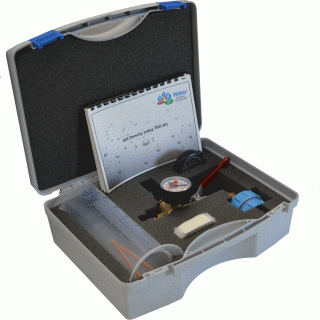SILT DENSITY INDEX TEST KIT – SDI001
|
COMPONENTS
|
|
|
USE OF KIT Silt Density Index (SDI) is an empirical test developed for measuring the rate of fouling of nano filtration (NF) or RO membranes. Suspended solids and colloidal materials in feed water are one of the biggest problems in reverse osmosis systems. Although most systems have some pre-treatment, including 5-micron pre-filters, these fine particles are responsible for the fouling of reverse osmosis membranes. In order to measure the degree of this fouling problem, a concept called Silt Density Index is used. Here filtration rates are calculated by exposing a 0.45-micron filter to the feed water under pressure. An SDI of less than 5 is typically considered acceptable for the reverse osmosis systems. This means membranes should foul at a very low rate at SDI values of less than 5. Although this concept works most of the time, there are exceptions when a lower SDI (less than 3) is desirable due to the nature of the suspended solids in the feed water. OPERATION SDI represents the potential for fouling of the membranes by finely suspended particles present in feed water to the membranes. There is no direct correlation between turbidity of a water stream and its SDI. Experience has shown that water with a very low turbidity (< 1 NTU) may have a high SDI value. Deep tubewell waters, as a rule, are free from suspended solids and exhibit a low turbidity value/SDI. On the other hand, surface water invariably contains high levels of fine suspended solids and therefore exhibits high turbidity as well as high SDI, calling for extensive pretreatment to achieve acceptable values of SDI and turbidity in feed water. GENERAL INFORMATION Depleting supplies of fresh water, ground water contamination and the rising cost of water have compelled industries to increasingly turn to the desalination of brackish/sea water as well as water recovered from treated industrial effluent and secondary treated municipal sewage. All these recycled water systems use reverse osmosis (RO) system for removal of dissolved solids. The presence of finely divided particles in feed water to an RO system can cause serious problems as they are too small to be retained by conventional pretreatment systems they find their way to the RO membrane. The function of an RO membrane is to concentrate dissolved solids on one side of the membrane and allow water molecules to permeate through the other side. Suspended, colloidal particles are larger than dissolved solids and are also rejected by the membrane. These fine undissolved suspended particles tend to settle on the surface and, in the process, foul the membrane. The net result is an increase in feed pressure, reduced flow and high conductivity of permeate. Spiral wound and hollow fine fibre membranes are the most vulnerable and once fouled, cleaning of the element is often difficult. Filter paper colouration after the SDI test: i) Slightly yellow The possible problem could be presence of iron and/or organics in feed water. Check the source. ii) Reddish brown Positive indication of presence of iron in feed water. Take corrective steps for removal of iron. iii) Gray Indicates presence of carbon fines. Check the carbon filter, remove carbon fines. iv) Particles present on Check the cartridge filter and the filter elements. the filter paper v) Dark Black If the colour dissolves in the acid, it indicates the presence of manganese in the water.
|
|







